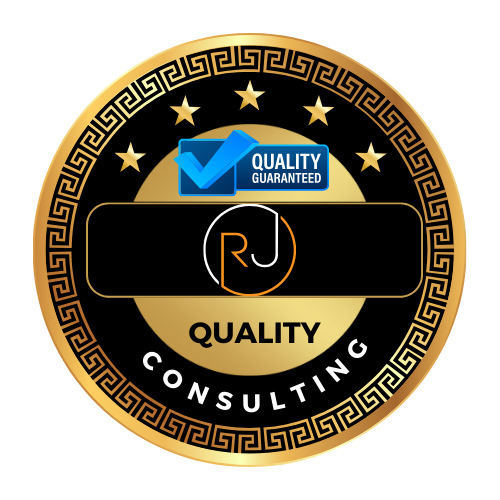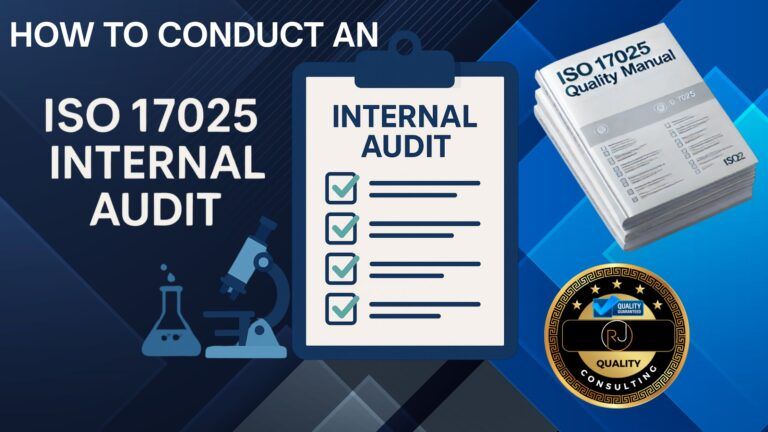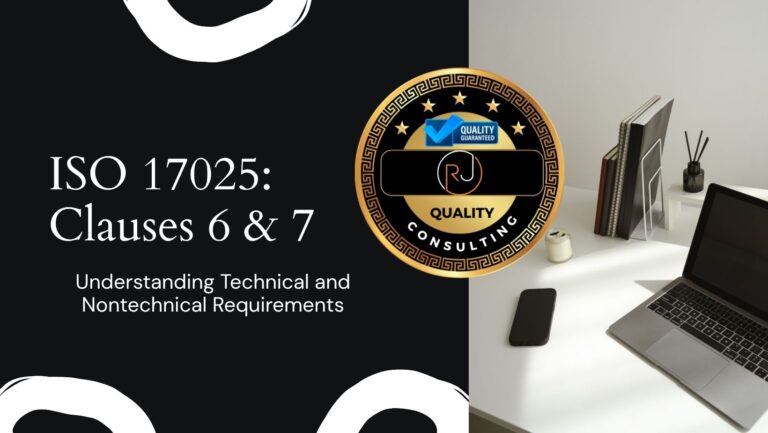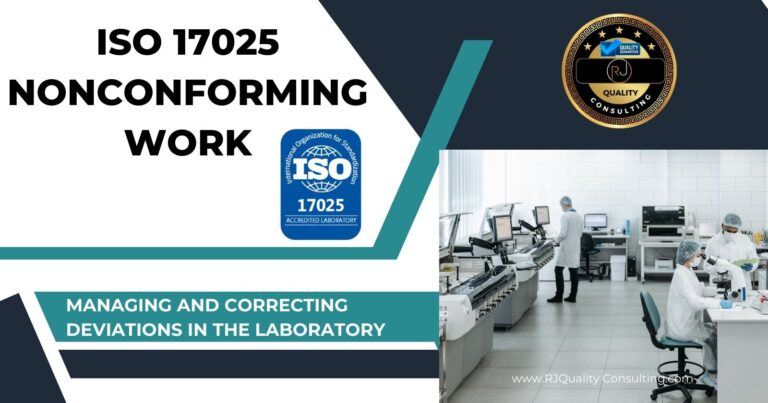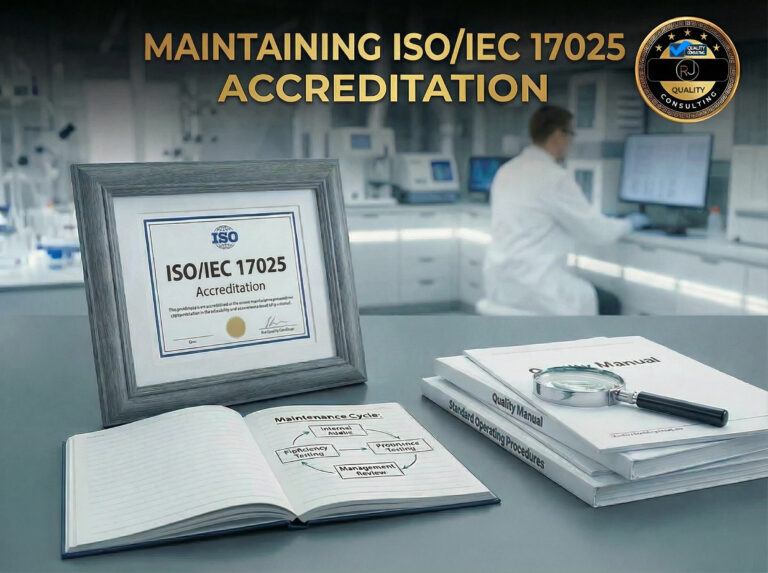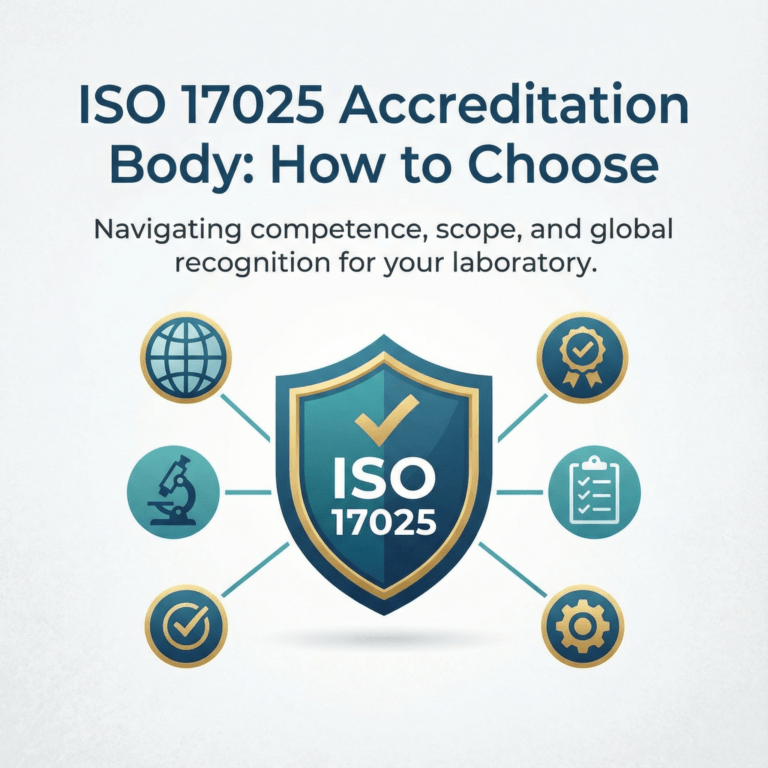ISO 17025 Documentation Requirements: A Comprehensive Guide
ISO/IEC 17025:2017 outlines the general requirements for the competence, impartiality, and consistent operation of testing and calibration laboratories. Central to achieving compliance with this standard is adhering to the ISO 17025 documentation requirements, which ensure that laboratories maintain accurate and comprehensive records of their processes, procedures, and quality management systems. This guide provides an in-depth look at both the mandatory and recommended documentation essential for laboratories to streamline their operations and uphold the highest standards of quality and reliability.
For a concise overview of the ISO 17025 documentation requirements, you can watch the following summary video before exploring the detailed guide.
Why Documentation is Important in ISO 17025
ISO/IEC 17025 Implementation Masterclass
Complete documentation + step-by-step training to get your lab accreditation-ready with confidence.
What you get (features)
- Customizable Quality Manual aligned to ISO/IEC 17025
- All required policies & procedures with matching forms/templates
- 7 training modules (Clauses 4–8, internal audit & management review)
- 20-question quiz + certificate of completion
- Clear instructions on tailoring documents to your lab
Why it matters (benefits)
- Implement faster with proven, audit-ready templates
- Train your team consistently and reduce nonconformities
- Show competence to assessors with documented training & certificate
- Confidently prepare for internal & external audits
- Move from “paper compliance” to a working quality system
Documentation is the foundation of a laboratory’s compliance with ISO/IEC 17025. It not only serves as proof of adherence to the standard but also provides a systematic approach to managing processes, ensuring consistency, and maintaining the quality of laboratory activities. Without proper documentation, laboratories risk inefficiencies, inconsistencies in testing or calibration results, and non-compliance during accreditation audits. The first high level document you should create is the ISO 17025 quality manual.
Maintaining up-to-date documentation helps laboratories establish traceability, demonstrating how testing and calibration are performed, recorded, and reviewed. It also plays a crucial role in staff training, ensuring that laboratory personnel have clear guidelines to follow. Additionally, well-organized documentation can help labs identify risks and areas for improvement, ultimately strengthening their quality management system. One way to ensure all documentation requirements are met is to use ISO 17025 templates to ensure each of the documentation requirements are met.

Proper documentation ensures:
- Compliance with accreditation requirements
- Consistency in laboratory operations
- Traceability of results and decision-making
- Improved efficiency and risk management
Mandatory ISO 17025 Documentation Requirements
ISO 17025 requires laboratories to maintain specific documentation to ensure compliance, accuracy, and consistency in operations. Below is a comprehensive list of mandatory documents that an accredited laboratory must have. These documents provide the necessary structure to demonstrate adherence to the standard’s requirements and serve as references during audits and quality assessments.
Below is a list of key mandatory documents required for ISO 17025 compliance:
| Clause (ISO 17025:2017) | Document / Record |
|---|---|
| 4.1 Impartiality | Impartiality policy or statement, Impartiality risk assessment records |
| 4.2 Confidentiality | Confidentiality agreements / policy |
| 5.3 Range of laboratory activities | Scope of laboratory activities document |
| 5.5 Structural requirements | Documented procedures for lab activities |
| 6.2 Personnel | Personnel competence requirements document, Competence and training procedure, Personnel records (qualifications, training, authorizations) |
| 6.3 Facilities & Environment | Environmental requirements documentation, Environmental monitoring records |
| 6.4 Equipment | Equipment management procedure, Equipment & reference material records |
| 6.5 Metrological traceability | Calibration certificates (traceability evidence) |
| 6.6 Externally provided products & services | External provider (purchasing) procedure, External provider evaluation records |
| 7.1 Review of requests, tenders, contracts | Contract review procedure, Contract review records |
| 7.2 Selection & Validation of Methods | Documented method procedures (test & calibration methods), Method verification records, Method deviation authorization record, Method validation records |
| 7.3 Sampling | Sampling plan and method procedure, Sampling records (if applicable) |
| 7.4 Handling of test/calibration items | Sample/item handling procedure, Identification & condition records, Item storage condition records (if applicable) |
| 7.5 Technical records | Technical records of test/calibration results, Amendments/corrections tracking |
| 7.6 Measurement uncertainty | Measurement uncertainty records (budgets & calculations) (for calibrations; as applicable for testing) |
| 7.7 Ensuring validity of results | Quality control/validity monitoring procedure, Quality control records (e.g. QC charts, proficiency test results) |
| 7.8 Reporting of results | Decision rule documentation (if statements of conformity are given) |
| 7.9 Complaints | Complaint handling procedure, Complaint records |
| 7.10 Nonconforming work | Nonconforming work procedure, Nonconforming work records |
| 7.11 Control of data & information | Software and LIMS validation records (if applicable) |
| 8.2 Management system documentation | Quality policy and objectives |
| 8.3 Control of documents | Document control procedure |
| 8.4 Control of records | Record control procedure |
| 8.7 Corrective actions | Corrective action records |
| 8.8 Internal audits | Internal audit program & procedure, Internal audit records |
| 8.9 Management reviews | Management review records |
Recommended ISO 17025 Documentation
Recommended Documentation Practices
While the above documents are mandatory, implementing the following practices can enhance your laboratory’s documentation system:
- Document Control: Establish a procedure to ensure all documents are reviewed, approved, and updated as necessary. This includes maintaining a document register and version control to track changes effectively.
- Record Keeping: Develop a system for the identification, storage, protection, retrieval, retention, and disposal of records. Ensure that records are legible, readily identifiable, and traceable to the relevant activity.
- Training and Competence: Maintain detailed records of personnel qualifications, training programs, and competency assessments. Regularly review and update training materials to reflect current standards and practices.
- Internal Audits and Management Reviews: Schedule regular internal audits to assess the effectiveness of the management system and compliance with ISO 17025 requirements. Document findings and corrective actions, and conduct management reviews to evaluate overall performance and identify opportunities for improvement.
- Risk Management: Incorporate risk assessment records to identify potential nonconformities and implement preventive actions. This proactive approach helps in mitigating risks before they impact laboratory operations.
While not explicitly required, the following documents enhance compliance and efficiency:
| Clause (ISO 17025:2017) | Document / Record |
| 5.5 Structural requirements | Organizational structure & responsibilities |
| 7.2 Selection & Validation of Methods | Method validation procedure or plan |
| 7.6 Measurement uncertainty | Uncertainty estimation procedure |
| 7.8 Reporting of results | Report templates and format, Opinions and interpretations record (if offering opinions), Amended report procedure |
| 7.11 Control of data & information | Data integrity and security procedure |
| 8.2 Management system documentation | Quality Manual (QMS documentation) |
| 8.5 Actions to address risks & opportunities | Risk management records (risk register), Risk & opportunity procedure |
| 8.6 Improvement | Improvement log or program |
| 8.7 Corrective actions | Corrective action procedure |
| 8.9 Management reviews | Management review procedure/agenda |
Implementing Effective Documentation
Establishing robust documentation practices is crucial for laboratories aiming to comply with ISO/IEC 17025:2017. Here are key strategies to ensure effective documentation:
- Develop Comprehensive Procedures and Work Instructions
- Standard Operating Procedures (SOPs): Create detailed SOPs for all critical laboratory processes, such as sample handling, equipment calibration, test execution, data analysis, and reporting. Ensure these documents are clear, concise, and easily accessible to relevant personnel.
- Regular Updates: Periodically review and update procedures to reflect current practices and standards.
- Implement Robust Document Control Measures
- Document Control System: Establish a system to manage the creation, review, approval, distribution, and archiving of documents. This ensures that only current and approved documents are in use, with obsolete versions promptly removed to prevent unintended use.
- Document Register: Maintain a register to track document statuses and revisions.
- Maintain Accurate and Accessible Records
- Systematic Record-Keeping: Develop a systematic approach to ensure all records are legible, readily identifiable, and easily retrievable. This includes records of test results, calibration data, equipment maintenance, training, and internal audits.
- Retention Policies: Implement retention policies that comply with regulatory requirements and protect records from damage or loss.
- Conduct Regular Internal Audits
- Audit Schedule: Establish a schedule to regularly assess the effectiveness of the management system and compliance with ISO/IEC 17025:2017 requirements.
- Documentation of Findings: Record audit findings and ensure that corrective actions are implemented and monitored for effectiveness.
- Engage in Continuous Personnel Training
- Training Programs: Provide ongoing training to ensure all personnel understand documentation requirements and their roles in maintaining the quality management system.
- Training Records: Keep detailed records of training sessions, including attendance and competency assessments.
- Utilize Digital Solutions for Document Management
- Electronic Document Management Systems (EDMS): Implement EDMS to streamline document control processes, enhance accessibility, facilitate version control, and improve efficiency in document retrieval and archiving.
- Compliance and Security: Ensure that electronic systems comply with data integrity and security requirements.
- Foster a Culture of Continuous Improvement
- Staff Involvement: Encourage staff to participate in developing and refining documentation.
- Feedback Mechanisms: Establish channels to capture suggestions for improvement and regularly review documentation practices to implement enhancements.
By implementing these strategies, laboratories can establish a robust documentation system that not only meets ISO/IEC 17025:2017 requirements but also supports operational excellence and continuous improvement.
How to Organize Your ISO 17025 Documentation

To maintain an effective quality management system:
- Use a Quality Manual – Consolidate policies and procedures for ease of access.
- Keep Records Well-Structured – Maintain digital or physical logs that are easy to retrieve.
- Implement Document Control Measures – Assign version numbers, review cycles, and approval workflows.
- Regularly Update Documents – Ensure they reflect current operations and standards.
Final Thoughts
Proper documentation is at the core of ISO 17025 compliance. Laboratories that maintain structured, well-organized documents not only meet the ISO 17025 technical requirements but also the ISO 17025 certification requirements to improve their operational efficiency. By integrating mandatory and recommended documentation practices, labs can ensure quality, consistency, and traceability in their testing and calibration activities.
Does your laboratory need help with ISO 17025 documentation? Contact us for expert guidance on structuring your quality management system!
🕒 Book Your Free 45-Minute Consultation
Have questions about ISO/IEC 17025 or ISO 9001 implementation or accreditation? Schedule a free 45-minute consultation with me to discuss your Company or laboratory’s needs and how we can achieve compliance together.
Schedule Your Consultation